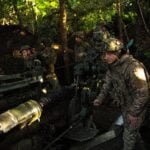For the U.S. and Australian pilots and ground crews operating out of a secluded base in the far reaches of Australia’s Northern Territory, Exercise Talisman Sabre 23 has provided a critical opportunity to train for the future of air warfare.
Throughout the 15-day exercise aimed at enhancing interoperability among key allies, U.S. Air Force pilots flew a series of elaborate training missions with their Royal Australian Air Force counterparts, involving multiple fighter, tanker and patrol aircraft.
“You’re talking about getting 40 to 50 aircraft all up in the same piece of sky — super complex,” said Air Force Capt. Christopher Loo, an F-22 pilot with the 199th Expeditionary Fighter Squadron based out of Joint Base Pearl Harbor-Hickam, Hawaii.
“It’s all basically practicing how we play,” he said. “It’s getting us ready for the next big fight because that’s how we force package and how we actually go to war.”
Loo’s unit, based during the exercise out of RAAF Base Tindal about 200 miles southeast of Darwin, is one of several U.S. squadrons operating out of bare-bones bases scattered throughout northern and western Australia.
In addition to Tindal, the U.S. and Australia have operated side-by-side from RAAF Base Darwin and RAAF Base Curtin in western Australia. They’re fielding U.S. F-22 and KC-46 Pegasus aircraft alongside a variety of Australian aircraft, including the F-35 A Lightning II, F/A-18F Super Hornet, E/A 18G Growler, KC-30A Multi-Role Tanker Transport, and P-8A Poseidon.
The deployment-like setting and large-scale training missions reflect the reality of operating out of the Indo-Pacific, said Air Force Lt. Col. Paul Lopez, commander of the 199th Air Expeditionary Squadron.
“I think it’s putting the airmen in the right mindset from a readiness perspective,” he said. “Whenever the military instrument of power is called upon, we have to be ready to go. And I think exercises, such as Talisman Sabre 23, provide an environment for us to exercise some of those skill sets.”
This year marks the 10th iteration of Talisman Sabre, a biennial exercise designed to advance a free and open Indo-Pacific. The spelling of the name — sabre vs. saber — reflects which country is leading the exercise: Talisman Sabre when Australia leads and Talisman Saber when the U.S. leads.
Nearly 30,000 troops from 13 different countries are participating this year. Several Pacific Island partners — including Papua New Guinea, Fiji and Tonga — are participating for the first time.
Throughout the exercise — which includes large-scale logistics, amphibious assault training operations, multinational firepower demonstrations, field training exercises and large-scale air-warfare training missions — leaders have emphasized the importance of deepening U.S. interoperability with partner forces in the region.
That interoperability is essential — not just for the pilots in the cockpit, but also for the maintainers, fuelers, weapons specialists and planners on the ground who have sustained the can-do grit needed to meet the demands of a future fight, Lopez said.
The U.S. Air Force has worked extensively to shape its force structure at the tactical level to become agile teams that are capable of deploying the lean and lethal forces required to succeed in combat environments.
By seizing on the partnerships forged in the region, the U.S. and its allies can better tap into critical skillsets across the coalition.
“We’re literally force multiplying by working across our nations,” said Wing Commander Fiona Pierce, commanding officer of No. 17 Squadron who overseas operations at RAAF Tindal.
The exercise has provided a critical platform for airmen from the deployed squadrons to work alongside their Australian counterparts and share best practices essential for achieving mission success.
Air Force Staff Sgt. Andrew Borja, who’s assigned to the 254th Security Forces Squadron based in Guam is at RAAF Tindal for the exercise, said the opportunity to train with his Australian counterparts has been crucial.
“When it comes down to it, it is one big fight with everyone, and we need to be tighter with our own allies,” he said. “That way, we know how to operate more efficiently as one team.”
Borja spoke from a small arms range on Tindal yesterday, where U.S. security forces conducted a live-fire familiarization shoot on the Australian Defence Force’s newly fielded EF88 Austeyr rifle.
Similar integration occurred among U.S. and Australian maintainers, weapons specialists and refuelers throughout the exercise.
U.S. maintainers were given the opportunity to observe as Australian crews from the RAAF No. 75 Squadron performed aircraft inspections on Australian F-35s.
“I think it’s good to train with other countries, other allies to see how they work and how we work with one another,” said Air Force Airman 1st Class Melissa Ramiro, a crew chief with the 199th Expeditionary Fighter Squadron.
She said exercises like Talisman Sabre are critical for readiness.
That sentiment has taken root across both U.S. and Australian units.
Flight Lieutenant Mitchell, an F-35 pilot with RAAF No. 17 Squadron, said interoperability with allies has been emphasized throughout Australian units over the past few years.
“No matter the theater, now, we’re going to be working with the U.S.,” he said. “It’s just so much more seamless now. When we get together, we know what to expect from each other. It just makes everything a lot easier now.”
Source : Defense












